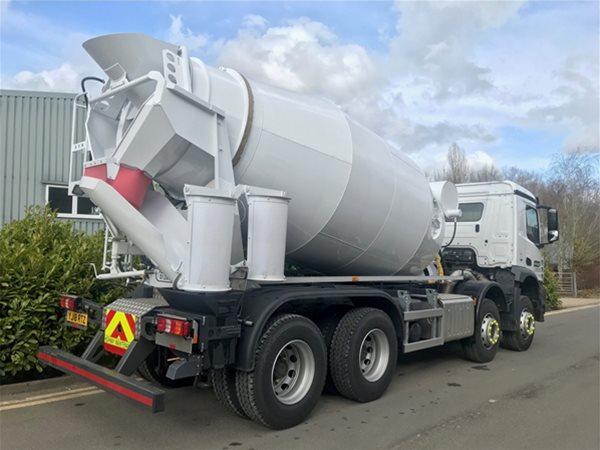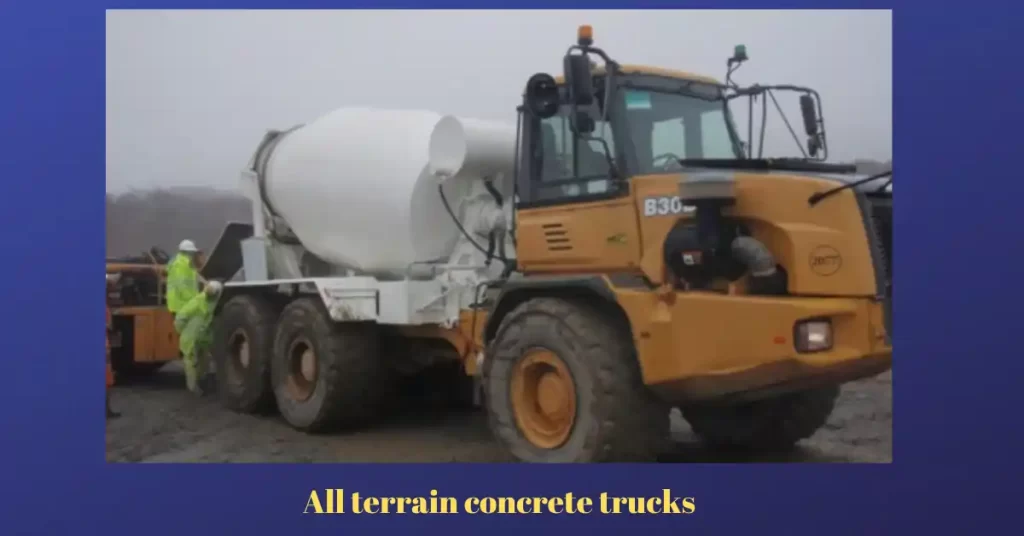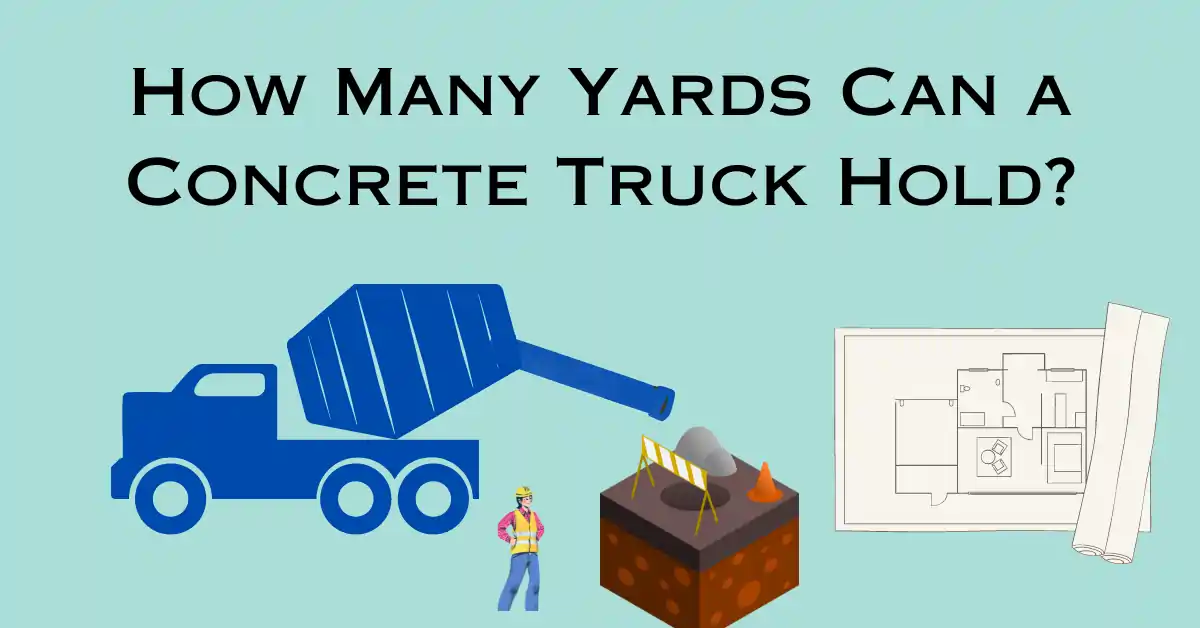Concrete is one of the most widely used construction materials in the world. It is composed of cement, water, sand, gravel, and sometimes other additives. Concrete is mixed in a central plant and then transported to the construction site by a concrete truck.
A concrete truck, also known as a cement mixer or a concrete mixer, is a specialized vehicle that has a rotating drum that mixes the concrete ingredients while in transit. The drum keeps the concrete from hardening and ensures a uniform consistency.
But how many yards can a concrete truck hold? And what are the different types of concrete trucks? In this blog post, we will answer these questions and provide some useful information and tips on how to order and use concrete trucks for your projects.
How Many Yards Can a Standard Concrete Truck Hold?
The capacity of a concrete truck can vary depending on the type, model, and manufacturer of the vehicle. However, a standard-sized concrete truck typically transports between 8 and 11 yards of concrete. This is enough concrete to pour a foundation for a small home or a garage or to build a patio, a walkway, or some steps.
The most commonly used concrete is a standard concrete truck that is employed to transport ready-mix concrete to significantly longer distances. The volume that this type of concrete truck can carry is capped by weight limits when passing road infrastructure. The weight limitation in most US states is 80,000 lb. A track can weigh a maximum of 30000 lb. The volume of concrete allowed will be 50,000 lb. That means 12.5 yards. Deducting wastage of 10%, the concrete truck volume allowed and so most common is 11 yards.
However, it’s important to note that the actual amount of concrete that a truck can deliver may be less than its nominal capacity. This is because some factors can affect the volume and weight of the concrete, such as:
- The type and amount of cement and aggregates used
- The water-cement ratio and the moisture content of the materials
- The temperature and humidity of the environment
- The air entrainment and admixtures added to the mix
- The slump or workability of the concrete
Therefore, it’s advisable to order slightly more concrete than you need to account for any possible variations or losses. You can also consult with your concrete supplier or contractor to determine the exact amount of concrete you need for your project.
What Are the Different Types of Concrete Trucks with respect to size?
Besides the standard-sized concrete truck, there are other types of concrete trucks that have different capacities and functions. Here are some of the most common ones:
- Large Concrete Truck: A large concrete truck can hold up to 14 yards of concrete. This is enough to pour a foundation for a large home or a commercial building. A large concrete truck is suitable for projects that require a large amount of concrete in one delivery.

- Mini Concrete Truck: A mini concrete truck can hold up to 4 yards of concrete1. This is enough to pour a small slab, a curb, or a sidewalk. A mini concrete truck is ideal for projects that have limited space or access, or that require small batches of different types of concrete.

What Are the Different Types of Concrete Trucks with respect to purpose of use?
Standard transit concrete trucks: These types of concrete trucks also known as transit mixers, transport freshly mixed concrete from batching plants to construction sites. They have cylindrical mixing drums 8-14 yards) that rotate during transit to maintain concrete consistency. Operated by skilled drivers, these trucks efficiently deliver high-quality concrete, ensuring it remains workable until placement at the construction site.

Volumetric Concrete Truck: A volumetric concrete truck is also known as a mobile batch plant or a mobile mixer. It has separate compartments for cement, water, sand, and gravel, and can mix the concrete on-site according to the desired specifications. A volumetric concrete truck can hold up to 10 yards of unmixed materials, which can produce up to 8 yards of mixed concrete. This type of truck is convenient for projects that require custom mixes or multiple deliveries.

Rough terrain self-loading concrete trucks: These are robust 4×4 wheel drive vehicles designed for challenging terrains. Featuring a front operator’s cab, these trucks can effortlessly navigate steep gradients up to 30 degrees while fully loaded with cement. They excel at loading, mixing, producing, and discharging over 100m3 of cement daily, thanks to electronic weigh batching equipment that ensures precise concrete mixes of any grade. Operated with ease using joystick controls, these trucks boast a 300-degree slewing drum, enabling concrete discharge at heights exceeding 2m from any side of the vehicle. Their compact design and maneuverability make them especially suitable for tunneling projects. Available in various sizes, from 1.3 to 7.1 yards, with options for fixed or slewing drums, these trucks are Ideal for delivering ready-mixed concrete in challenging, inaccessible locations, Rough terrain concrete trucks are the go-to choice for demanding construction sites with unforgiving landscapes.

All-terrain concrete trucks: These types of concrete trucks are specialized vehicles designed for the efficient transportation of ready-mixed concrete to challenging and remote locations. These innovative machines are built on the foundation of a robust 30-tonne articulated dump truck chassis, making them exceptionally capable of navigating rugged terrains and reaching areas that are inaccessible to traditional road-based concrete trucks.
One of the key features that set all-terrain concrete trucks apart is their 8.5-yard concrete drum. This substantial capacity ensures that a significant volume of concrete can be transported in a single trip, increasing efficiency and reducing the need for frequent refilling. This feature is particularly advantageous when delivering concrete to construction sites in remote or difficult-to-reach areas.

These specialized vehicles play a pivotal role in the successful delivery of ready-mixed concrete in locations where conventional road-based trucks would be impractical. Their off-road capabilities, coupled with their substantial concrete drum capacity, make them invaluable assets in construction projects that demand flexibility and adaptability in concrete transportation. Whether it’s remote construction sites, challenging terrains, or areas with limited road access, all-terrain concrete trucks excel in delivering concrete precisely where it’s needed, ensuring the seamless progress of construction projects.
By combining the durability and versatility of dump truck chassis with the specific requirements of concrete delivery, all-terrain concrete trucks have become indispensable tools in the construction industry, facilitating the completion of projects in the most demanding and inaccessible environments.:
Tracked concrete trucks: These concrete trucks are the result of a collaboration between two industry leaders, PRINOTH and McNeilus, that engineered special vehicles for off-road concrete placement. These specialized vehicles are constructed on a robust tracked carrier known for its substantial payload capacity, ideal for transporting heavy equipment in challenging terrains. The trucks have a 9-yard capacity.

The custom mixer body, designed to maximize payload and simplify attachment to the tracked carrier, features tailored hydraulic components for durability in rugged environments. It efficiently transfers concrete from on-road trucks, reducing wait times at construction sites.
One notable design element is the lowered frame chassis of the tracked carrier, enhancing stability and off-road performance by reducing overall height. These tracked concrete trucks revolutionize access to remote or challenging sites, saving time compared to traditional methods, such as costly helicopter transport for concrete delivery.
How long can it take to pour 10 yards of concrete?
The time required to pour 10 yards of concrete varies based on crew size, equipment, project complexity, and weather conditions. The time required normally includes pouring and placing, with additional time for preparation, setup, and finishing.
Concrete can be poured quickly if dumped into a large formwork or to simple structural elements like slabs. When placing concrete for a parking lot,10 cubic yards can be placed in 5 min. For intricate work, like maintaining grade on a slab, it might take an hour. Placing concrete for a bridge deck, 10 cubic can take 25 min.
If multiple trucks are used, delays can occur which is possible because of the limit of loading of 9 yards on many public highways. Companies allocate about 90 minutes per load for unloading, plus time for bull floating and waiting for bleed water.
ASTM C 94 sets a 90-minute limit for discharge and before 300 revolutions on-site after water-cement mixing, but this can be changed by the purchaser. Specifications limit that Concrete should be Discharged within 90 min. & screeded within 105 min for temperature between 50 – 80o F.
For warmer weather between temperatures of 80 – 90oF, the time gets shorter and the concrete should be discharged within 45 min. & screeded within 60 minThe use of additives like retarding admixtures can prolong the time.
So generally professional workers claim 30 to 45 minutes is enough for discharging the concrete. However, it depends on the factors that influence the setting time of the concrete.
How much does a truck of concrete cost?
The cost of a truckload of concrete, commonly referred to as “ready-mix concrete,” can vary widely depending on several factors such as location, concrete mix design, and current market conditions. Here’s a general idea of what you might expect:
The cost of a truck of concrete depends on several factors, such as the amount of concrete, the type of concrete, the delivery distance, the local market, etc. According to various sources, the average cost of concrete delivery in the US is $108 per cubic yard, and $53 per cubic yard for short loads (less than 10 cubic yards).
A full truckload of concrete is about 10 cubic yards and costs between $1,169 and $1,444 depending on the PSI mix. However, these prices may vary depending on your location and the time of the year.
Once a concrete mixing truck is loaded and the drum turning, how much time does the operator have before the concrete has to be poured?
The time limit for a concrete mixing truck to pour the concrete before it starts to harden depends on the specifications and standards of the concrete and the transportation conditions. ASTM C-94, which is a common specification for ready-mixed concrete in the US, states that the discharge of the concrete shall be completed within 1 ½ hours after the introduction of the mixing water to the cement and aggregates, or the cement to the aggregates. However, this time limit can be extended or reduced by the specifier or the producer depending on the temperature, humidity, admixture, mix design, etc. In some cases, the time limit can be up to 3 to 4 hours without damaging the concrete quality.
In other countries, such as the UK, the time limit may be different. For example, BS 8500-2 Clause 14.2 requires concrete to be delivered within 2 hours for truck mixers or agitators, or within 1 hour for non-agitating equipment.
How does concrete not harden in a truck?
Concrete does not harden in a truck because it is constantly being mixed and agitated by the rotating drum. This prevents the concrete from settling and forming bonds between the cement and the aggregates.
Concrete mixtures often include chemical admixtures, such as water reducers and retarders. Retarders are additives that slow down the hydration process of cement, giving the concrete a longer setting time. This helps extend the time the concrete remains workable, even while in transit. The concrete also stays moist and fresh inside the truck, which is important for the hydration process that allows the cement to turn into a gel and fill the gaps between the aggregates.
In some cases, especially in hot weather, concrete mixing trucks might have cooling systems to prevent the temperature from rising too high. Elevated temperatures can accelerate the hydration process, potentially leading to premature setting.
In construction works, concrete mixer trucks are dispatched in a way that ensures they arrive at the site of discharge within the desired timeframe. Dispatchers consider factors like travel distance, traffic conditions, and the estimated setting time of the concrete.
Thus, effective communication between the concrete supplier, truck operator, and construction site ensures that the concrete is poured promptly upon arrival. This minimizes delays and ensures that the concrete is placed before it starts to set.
However, concrete can harden in a truck if it is not mixed or poured within a certain time limit, usually around 90 minutes after loading. Therefore, it is important to plan ahead and coordinate the delivery and placement of concrete to avoid wasting time and material.
what is the setting time of concrete?
The setting time of concrete refers to the period during which the concrete undergoes a transition from a fluid, workable state to a solid state. This process is primarily governed by the hydration reactions between cement particles and water, which leads to the formation of a solid matrix that binds the aggregates together.
There are two primary stages of setting in concrete: Initial and final setting time.The setting time of concrete is the time it takes for the concrete to harden enough to resist deformation. It depends on many factors, such as the type of cement, the water-cement ratio, the temperature, the admixtures used, etc.
The initial setting time is when the concrete can be handled without damage, and the final setting time is when the concrete reaches its full strength. The initial setting time of concrete is usually between 30 minutes to 90 minutes and the final setting time is usually between 6 hours to 10 hours. However, these times can vary depending on various factors.
Factors Affecting Setting Time:
Different types of cement have varying chemical compositions, leading to different hydration rates and setting times. Higher temperatures can accelerate the hydration process, leading to faster setting times, while lower temperatures can slow it down.
The amount of water in the mix affects the rate of hydration and consequently the setting time. Retarders and accelerators can be added to the mix to respectively extend or shorten the setting time. The proportions of cement, aggregates, water, and admixtures in the mix influence the time as well. Humidity, wind, and sunlight also can impact the rate of hydration and setting.
Conclusion
Concrete trucks are essential vehicles for transporting and delivering concrete to construction sites. They come in different sizes and types, each with its own capacity and function. Knowing how many yards a concrete truck hold can help you plan and execute your projects more efficiently and effectively. The time that takes to pour concrete also is dependent on the time of setting of the concrete mix, environmental conditions, and the type of work.

